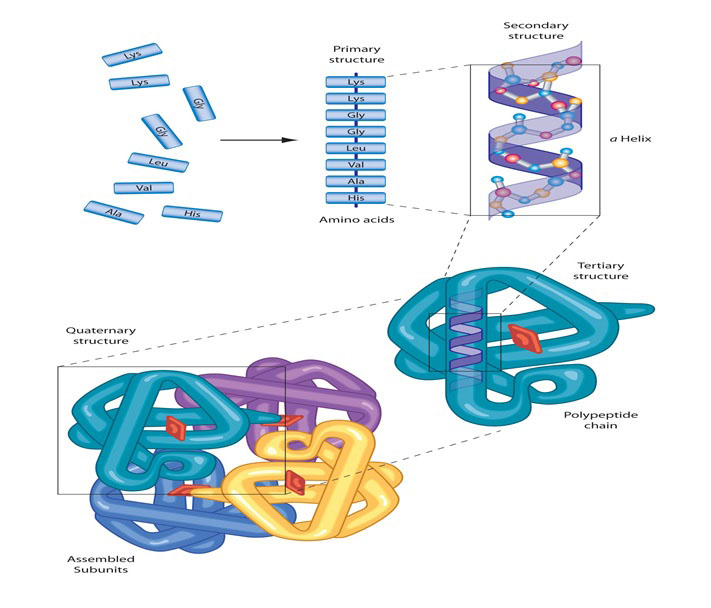A Periodic Table for Protein Structures Reveals Biochemical Design
During my senior year of high school, I was the proud winner of the Periodic Table Competition at the West Virginia State Science and Engineering Fair—and I still have the trophy to prove it! My victory that day sealed my fate as a geek and foreshadowed my future as a chemist and biochemist. For the next four years of college, and the ensuing years as a graduate student, the periodic table of elements was never far from my side.
In 1869, Russian chemist Dmitri Mendeleev devised the periodic table of elements. He discovered that ordering the chemical elements according to atomic number exposed periodic trends in the elements’ chemical and physical behavior. This periodicity allows scientists to make sense of the bewildering complexity of chemical systems and provides them with a user-friendly framework to organize and predict chemical and physical properties.
Biochemists have long sought to discover a similar framework to organize and predict the structure and function of biomolecules, such as protein complexes. It hasn’t been clear if it’s even possible to order and organize biochemical systems because many scientists regard biochemical systems as the product of an unguided, historically contingent evolutionary history. According to Joe Marsh, “Evolution has given rise to a huge variety of protein complexes, and it can seem a bit chaotic.”1
Without any organizing principles to guide their work, biochemists have been forced to characterize the structure of protein complexes on a case-by-case basis. Biochemists have solved the structure of thousands of protein complexes, yet they haven’t been able to identify a framework that accounts for these structures, assuming one even exists.
The historical contingency of the evolutionary process seems to provide a reasonable explanation for this bewildering array. Presumably, these unguided processes transformed preexisting proteins into complexes that, in turn, have been shaped by natural selection to perform key functions in the cell. In other words, there is no underlying rhyme or reason to the structure of protein complexes. They merely reflect a history governed by random changes operated on by natural selection.

Periodic Table of Protein Complexes
However, recent insights indicate that the laws of nature may fundamentally dictate the organization, structure, and function of biochemical systems.2 Scientists from the United Kingdom added to these insights when they discovered a way to create a biochemical periodic table that explains and predicts the structures of protein complexes observed in nature.3
In my view, the existence of a simple set of rules that accounts for protein complex structures points to an underlying orderliness and purpose to the universe that reflects the work of an intelligent Creator.
Instead of analyzing the architecture of protein complexes to uncover structural principles, the research team focused on the protein complex assembly process. They noted that protein complexes assemble in an orderly fashion that seems to be conserved across the biological realm. They identified three basic steps in the assembly processes:
- Dimerization, in which two identical protein subunits interact to form a complex
- Cyclization, in which a ring of three or more identical subunits forms
- Addition, in which two different subunits join to form a dimer
The researchers also recognized that the nature of the interactions between the subunits is important. They identified two types of interactions:
- Isologous, in which identical corresponding surfaces on the protein subunits interact (“head-to-head”)
- Heterologous, in which different surfaces between the subunits interact (“head-to-tail”)
By systematically going through multiple iterations of these steps, it is possible to identify a huge range of structures for protein complexes. The researchers discovered that by organizing the structures into columns (by number of unique subunits) and rows (by number of repeats), a periodic table of protein complexes emerged. This table accounted for 92 percent of all known protein complex structures. (Four percent of the unaccounted-for complexes was due to assignment errors.) Using their periodic table, the researchers were able to explain the frequency of occurrence for protein complex structures. They even predicted the structure of yet-to-be-discovered protein complexes.
As a biochemist, I find it stunning that these researchers were able to explain the baffling complexity of protein structures with a simple set of rules. Sebastian Ahnert, a member of the team, proclaimed, “We’re bringing a lot of order into the messy world of protein complexes.”4
The Implications
This work will have obvious implications for our fundamental understanding of protein structure-function relationships. It will also have important biomedical applications because faulty assembly of protein complexes contributes, in part, to the etiology of a number of diseases. A protein complex periodic table will also be a useful tool for work in biotechnology and protein engineering.
As a Christian, I also see important theological and apologetic implications. Remember that according to evolutionary theory, we should not expect to see underlying rhyme or reason to protein complex structure. Yet this latest discovery highlights exactly that—orderliness and intelligibility in nature. Such a scenario harmonizes with the Christian worldview’s belief that God, who has revealed Himself to human beings through His creation, created the universe.
This advance also means that yet another key biochemical feature is not historically contingent but is fundamentally specified by the laws of nature. This reality strikes down a tenet of evolutionary theory. It also means that shared structural features of protein complexes cannot be used to infer evolutionary relationships.
This discovery also lends support to the existence of a biochemical anthropic principle. It is remarkable to think that protein complexes are a manifestation of the laws of nature and are, at the same time, precisely the types of structures life needs to exist. I interpret this “coincidence” as evidence that our universe has been designed for a purpose.
Finally, while this insight challenges evolutionary theory, it also challenges one of the most popular arguments for intelligent design—namely, the use of probability calculations to demonstrate that random processes can’t generate information-rich biomolecules, such as proteins. As I’ve pointed out before, this line of argumentation is faulty.5 The work by the UK team demonstrates that if protein structures are specified by the laws of nature, then physicochemical (and maybe even biochemical) constraints force proteins into a limited region of protein space. Though protein space is vast, in principle, in reality much of it can’t be occupied because only a subset of protein structures is viable per the laws of physics and chemistry.
Overall, the new periodic table for protein complexes reveals that the structure of biological systems may reflect some deep and underlying principles that arise from the very nature of the universe itself. And as a Christian, I find that notion to resonate powerfully with the idea that life manifests from an intelligent agent—namely, God.
Endnotes
- European Molecular Biology Laboratory-European Bioinformatics Institute, “Periodic Table of Protein Complexes,” news release, ScienceDaily, December 10, 2015, www.sciencedaily.com/releases/2015/12/151210144539.htm.
- For example, see Fazale Rana, “How the Central Dogma of Molecular Biology Points to Design,” Today’s New Reason to Believe (blog), Reasons to Believe, February 9, 2015, https://www.reasons.org/articles/how-the-central-dogma-of-molecular-biology-points-to-design; and Fazale Rana, “Too Good to Be True: Evolution and the Origin of Bioinformation,” Today’s New Reason to Believe (blog), Reasons to Believe, July 11, 2013, https://www.reasons.org/articles/too-good-to-be-true-evolution-and-the-origin-of-bioinformation.
- Sebastian E. Ahnert et al., “Principles of Assembly Reveal a Periodic Table of Protein Complexes,” Science 350 (December 2015), doi:10.1126/science.aaa2245.
- European Molecular Biology Laboratory-European Bioinformatics Institute, “Periodic Table of Protein Complexes.”
- See Fazale Rana, “Intelligent Design: The Right Conclusion, but the Wrong Reasons,” Today’s New Reason to Believe (blog), Reasons to Believe, October 7, 2010, http:/www.reasons.org/articles/intelligent-design-the-right-conclusion-but-the-wrong-reasons; and Fazale Rana, “Too Good to Be True: Evolution and the Origin of Bioinformation,” Today’s New Reason to Believe (blog), Reasons to Believe, July 11, 2013, https://www.reasons.org/articles/too-good-to-be-true-evolution-and-the-origin-of-bioinformation.





